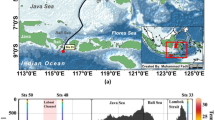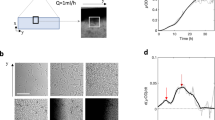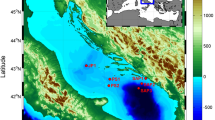Abstract
The sea squirt Ciona intestinalis is a well-studied model organism in developmental biology, yet little is known about its associated bacterial community. In this study, a combination of 454 pyrosequencing of 16S ribosomal RNA genes, catalyzed reporter deposition-fluorescence in situ hybridization and bacterial culture were used to characterize the bacteria living inside and on the exterior coating, or tunic, of C. intestinalis adults. The 454 sequencing data set demonstrated that the tunic bacterial community structure is different from that of the surrounding seawater. The observed tunic bacterial consortium contained a shared community of <10 abundant bacterial phylotypes across three individuals. Culture experiments yielded four bacterial strains that were also dominant groups in the 454 sequencing data set, including novel representatives of the classes Alphaproteobacteria and Flavobacteria. The relatively simple bacterial community and availability of dominant community members in culture make C. intestinalis a promising system in which to investigate functional interactions between host-associated microbiota and the development of host innate immunity.
Similar content being viewed by others
Log in or create a free account to read this content
Gain free access to this article, as well as selected content from this journal and more on nature.com
or
Accession codes
References
Amann RI, Binder BJ, Olson RJ, Chisholm SW, Devereux R, Stahl DA . (1990). Combination of 16S rRNA-targeted oligonucleotide probes with flow cytometry for analyzing mixed microbial populations. Appl Environ Microbiol 56: 1919–1925.
Barbieri E, Paster BJ, Hughes D, Zurek L, Moser DP, Teske A et al. (2001). Phylogenetic characterization of epibiotic bacteria in the accessory nidamental gland and egg capsules of the squid Loligo pealei (Cephalopoda:Loliginidae). Environ Microbiol 3: 151–167.
Blasiak LC, Clardy J . (2010). Discovery of 3-formyl-tyrosine metabolites from Pseudoalteromonas tunicata through heterologous expression. J Am Chem Soc 132: 926–927.
Blunt JW, Copp BR, Munro MH, Northcote PT, Prinsep MR . (2011). Marine natural products. Nat Prod Rep 28: 196–268.
Cammarata M, Arizza V, Cianciolo C, Parrinello D, Vazzana M, Vizzini A et al. (2008). The prophenoloxidase system is activated during the tunic inflammatory reaction of Ciona intestinalis. Cell Tissue Res 333: 481–492.
Caputi L, Andreakis N, Mastrototaro F, Cirino P, Vassillo M, Sordino P . (2007). Cryptic speciation in a model invertebrate chordate. Proc Natl Acad Sci USA 104: 9364–9369.
Christiaen L, Wagner E, Shi W, Levine M . (2009a). Whole-mount in situ hybridization on sea squirt (Ciona intestinalis) embryos. Cold Spring Harb Protoc 2009;: doi:10.1101/pdb.prot5348.
Christiaen L, Wagner E, Shi W, Levine M . (2009b). Electroporation of transgenic DNAs in the sea squirt. Ciona. Cold Spring Harb Protoc 2009;: doi:10.1101/pdb.prot5345.
Christiaen L, Wagner E, Shi W, Levine M . (2009c). Microinjection of morpholino oligos and RNAs in sea squirt (Ciona) embryos. Cold Spring Harb Protoc 2009;: doi:10.1101/pdb.prot5347.
Cole JR, Wang Q, Cardenas E, Fish J, Chai B, Farris RJ et al. (2009). The ribosomal database project: improved alignments and new tools for rRNA analysis. Nucleic Acids Res 37: D141–D145.
Collins AJ, LaBarre BA, Won BS, Shah MV, Heng S, Choudhury MH et al. (2012). Diversity and partitioning of bacterial populations within the accessory nidamental gland of the squid Euprymna scolopes. Appl Environ Microbiol 78: 4200–4208.
Consortium H . (2012). Structure, function and diversity of the healthy human microbiome. Nature 486: 207–214.
De Leo G, Patricolo E . (1980). Blue-green algalike cells associated with the tunic of Ciona intestinalis L. Cell Tissue Res 212: 91–98.
De Leo G, Patricolo E, Frittitta G . (1981). Fine Structure of the Tunic of Ciona intestinalis. Acta Zoologica 62: 259–271.
De Leo G, Parrinello N, Parrinello D, Cassara G, Russo D, Di Bella MA . (1997). Encapsulation response of Ciona intestinalis (Ascidiacea) to intratunical erythrocyte injection. J Invertebr Pathol 69: 14–23.
Dehal P, Satou Y, Campbell RK, Chapman J, Degnan B, De Tomaso A et al. (2002). The draft genome of Ciona intestinalis: insights into chordate and vertebrate origins. Science 298: 2157–2167.
Delsuc F, Brinkmann H, Chourrout D, Philippe H . (2006). Tunicates and not cephalochordates are the closest living relatives of vertebrates. Nature 439: 965–968.
Di Bella MA, De Leo G . (2000). Hemocyte migration during inflammatory-like reaction of Ciona intestinalis (Tunicata, ascidiacea). J Invertebr Pathol 76: 105–111.
Di Bella MA, Fedders H, Leippe M . (2011). Localization of antimicrobial peptides in the tunic of Ciona intestinalis (Ascidacea, Tunicata) and their involvement in local inflammatory-like reactions. Results Immunol 1: 70–75.
Dishaw LJ, Giacomelli S, Melillo D, Zucchetti I, Haire RN, Natale L et al. (2011). A role for variable region-containing chitin-binding proteins (VCBPs) in host gut-bacteria interactions. Proc Natl Acad Sci USA 108: 16747–16752.
Donia MS, Fricke WF, Partensky F, Cox J, Elshahawi SI, White JR et al. (2011). Complex microbiome underlying secondary and primary metabolism in the tunicate-Prochloron symbiosis. Proc Natl Acad Sci USA 108: E1423–E1432.
Edgar RC, Haas BJ, Clemente JC, Quince C, Knight R . (2011). UCHIME improves sensitivity and speed of chimera detection. Bioinformatics 27: 2194–2200.
Felsenstein J . (2005) PHYLIP (Phylogeny Inference Package) version 3.6. Distributed by the author Department of Genome Sciences, University of Washington: Seattle, WA, USA.
Franks A, Egan S, Holmstrom C, James S, Lappin-Scott H, Kjelleberg S . (2006). Inhibition of fungal colonization by Pseudoalteromonas tunicata provides a competitive advantage during surface colonization. Appl Environ Microbiol 72: 6079–6087.
Franks A, Haywood P, Holmstrom C, Egan S, Kjelleberg S, Kumar N . (2005). Isolation and structure elucidation of a novel yellow pigment from the marine bacterium Pseudoalteromonas tunicata. Molecules 10: 1286–1291.
Fraune S, Bosch TC . (2007). Long-term maintenance of species-specific bacterial microbiota in the basal metazoan. Hydra. Proc Natl Acad Sci USA 104: 13146–13151.
Guindon S, Dufayard JF, Lefort V, Anisimova M, Hordijk W, Gascuel O . (2010). New algorithms and methods to estimate maximum-likelihood phylogenies: assessing the performance of PhyML 3.0. Syst Biol 59: 307–321.
Holmstrom C, James S, Neilan BA, White DC, Kjelleberg S . (1998). Pseudoalteromonas tunicata sp. nov., a bacterium that produces antifouling agents. Int J Syst Bacteriol 48 ((Pt 4)): 1205–1212.
Huse SM, Welch DM, Morrison HG, Sogin ML . (2010). Ironing out the wrinkles in the rare biosphere through improved OTU clustering. Environ Microbiol 12: 1889–1898.
Huse SM, Ye YZ, Zhou YJ, Fodor AA . (2012). A core human microbiome as viewed through 16S rRNA sequence clusters. PLoS One 7: e34242.
Ishii K, Mussmann M, MacGregor BJ, Amann R . (2004). An improved fluorescence in situ hybridization protocol for the identification of bacteria and archaea in marine sediments. FEMS Microbiol Ecol 50: 203–213.
Kikuchi Y, Graf J . (2007). Spatial and temporal population dynamics of a naturally occurring two-species microbial community inside the digestive tract of the medicinal leech. Appl Environ Microbiol 73: 1984–1991.
Koropatnick TA, Engle JT, Apicella MA, Stabb EV, Goldman WE, McFall-Ngai MJ . (2004). Microbial factor-mediated development in a host-bacterial mutualism. Science 306: 1186–1188.
Lane DJ . (1991). 16S/23S rRNA sequencing. In Stackebrandt E, Goodfellow M, (eds) Nucleic Acid Techniques in Bacterial Systematics. John Wiley and Sons: New York, NY, USA, pp 115–175.
Ludwig W, Strunk O, Westram R, Richter L, Meier H, Yadhukumar et al. (2004). ARB: a software environment for sequence data. Nucleic Acids Res 32: 1363–1371.
Manz W, Amann R, Ludwig W, Vancanneyt M, Schleifer KH . (1996). Application of a suite of 16S rRNA-specific oligonucleotide probes designed to investigate bacteria of the phylum cytophaga-flavobacter-bacteroides in the natural environment. Microbiology 142 ((Pt 5)): 1097–1106.
Nyholm SV, Graf J . (2012). Knowing your friends: invertebrate innate immunity fosters beneficial bacterial symbioses. Nat Rev Microbiol 10: 815–827.
Parrinello N, Arizza V, Cammarata M, Giaramita FT, Pergolizzi M, Vazzana M et al. (2007). Inducible lectins with galectin properties and human IL1alpha epitopes opsonize yeast during the inflammatory response of the ascidian Ciona intestinalis. Cell Tissue Res 329: 379–390.
Parrinello N, Patricolo E, Canicatti C . (1977). Tunicate immunobiology. I. Tunic reaction of Ciona intestinalis L. to erythrocyte injection. Bolletino di zoologia 44: 373–381.
Pernthaler A, Pernthaler J, Amann R . (2002). Fluorescence in situ hybridization and catalyzed reporter deposition for the identification of marine bacteria. Appl Environ Microbiol 68: 3094–3101.
Pichon D, Gaia V, Norman MD, Boucher-Rodoni R . (2005). Phylogenetic diversity of epibiotic bacteria in the accessory nidamental glands of squids (Cephalopoda: Loliginidae and Idiosepiidae). Marine Biology 147: 1323–1332.
Pinto MR, Chinnici CM, Kimura Y, Melillo D, Marino R, Spruce LA et al. (2003). CiC3-1a-mediated chemotaxis in the deuterostome invertebrate Ciona intestinalis (Urochordata). J Immunol 171: 5521–5528.
Pruesse E, Peplies J, Glockner FO . (2012). SINA: accurate high-throughput multiple sequence alignment of ribosomal RNA genes. Bioinformatics 28: 1823–1829.
Quince C, Lanzen A, Davenport RJ, Turnbaugh PJ . (2011). Removing noise from pyrosequenced amplicons. BMC Bioinformatics 12: 38.
Rath CM, Janto B, Earl J, Ahmed A, Hu FZ, Hiller L et al. (2011). Meta-omic characterization of the marine invertebrate microbial consortium that produces the chemotherapeutic natural product ET-743. ACS Chem Biol 6: 1244–1256.
Riesenfeld CS, Murray AE, Baker BJ . (2008). Characterization of the microbial community and polyketide biosynthetic potential in the palmerolide-producing tunicate Synoicum adareanum. J Nat Prod 71: 1812–1818.
Sasaki N, Ogasawara M, Sekiguchi T, Kusumoto S, Satake H . (2009). Toll-like receptors of the ascidian Ciona intestinalis: prototypes with hybrid functionalities of vertebrate Toll-like receptors. J Biol Chem 284: 27336–27343.
Schloss PD, Westcott SL, Ryabin T, Hall JR, Hartmann M, Hollister EB et al. (2009). Introducing mothur: open-source, platform-independent, community-supported software for describing and comparing microbial communities. Appl Environ Microbiol 75: 7537–7541.
Schloss PD, Gevers D, Westcott SL . (2011). Reducing the effects of PCR amplification and sequencing artifacts on 16S rRNA-based studies. PLoS One 6: e27310.
Schmidt EW, Donia MS . (2010). Life in cellulose houses: symbiotic bacterial biosynthesis of ascidian drugs and drug leads. Curr Opin Biotechnol 21: 827–833.
Schmidt EW, Nelson JT, Rasko DA, Sudek S, Eisen JA, Haygood MG et al. (2005). Patellamide A and C biosynthesis by a microcin-like pathway in Prochloron didemni, the cyanobacterial symbiont of Lissoclinum patella. Proc Natl Acad Sci USA 102: 7315–7320.
Shade A, Hogan CS, Klimowicz AK, Linske M, McManus PS, Handelsman J . (2012). Culturing captures members of the soil rare biosphere. Environ Microbiol 14: 2247–2252.
Small KS, Brudno M, Hill MM, Sidow A . (2007). A haplome alignment and reference sequence of the highly polymorphic Ciona savignyi genome. Genome Biol 8: R41.
Turnbaugh PJ, Hamady M, Yatsunenko T, Cantarel BL, Duncan A, Ley RE et al. (2009). A core gut microbiome in obese and lean twins. Nature 457: 480–484.
Wang Q, Garrity GM, Tiedje JM, Cole JR . (2007). Naive Bayesian classifier for rapid assignment of rRNA sequences into the new bacterial taxonomy. Appl Environ Microbiol 73: 5261–5267.
Acknowledgements
Funding was provided by the National Science Foundation (NSF) Directorate for Biological Sciences Integrative Organismal Systems (IOS-0919728), Fogarty International Center, National Cancer Institute, National Institute of Allergy and Infectious Diseases, National Institute of Mental Health, National Institute on Drug Abuse, National Heart Lung and Blood Institute, National Center for Complementary and Alternative Medicine, Office of Dietary Supplements, National Institute of General Medical Sciences, Biological Sciences Directorate of the NSF, and the Office of Biological and Environmental Research of the US Department of Energy under Cooperative Agreement U01 TW00313 with the International Cooperative Biodiversity Groups. Leah C Blasiak was supported by the Selman A Waksman Endowed Scholarship in Microbial Diversity funded by the Gordon and Betty Moore foundation while a participant in the Marine Biological Laboratories Microbial Diversity Course in Woods Hole. We thank Sara Kleindienst, Charles Pepe-Ranney, and Elizabeth Wilbanks for valuable input, and the MBL for use of its LSCM facilities. This is IMET contribution no. 13–111 and UMCES contribution no. 4812.
Author information
Authors and Affiliations
Corresponding author
Ethics declarations
Competing interests
The authors declare no conflict of interest.
Additional information
Supplementary Information accompanies this paper on The ISME Journal website
Supplementary information
Rights and permissions
About this article
Cite this article
Blasiak, L., Zinder, S., Buckley, D. et al. Bacterial diversity associated with the tunic of the model chordate Ciona intestinalis. ISME J 8, 309–320 (2014). https://doi.org/10.1038/ismej.2013.156
Received:
Revised:
Accepted:
Published:
Issue date:
DOI: https://doi.org/10.1038/ismej.2013.156
Keywords
This article is cited by
-
Major ocean currents may shape the microbiome of the topshell Phorcus sauciatus in the NE Atlantic Ocean
Scientific Reports (2021)
-
Composition and geographic variation of the bacterial microbiota associated with the coelomic fluid of the sea urchin Paracentrotus lividus
Scientific Reports (2020)
-
Core and Dynamic Microbial Communities of Two Invasive Ascidians: Can Host–Symbiont Dynamics Plasticity Affect Invasion Capacity?
Microbial Ecology (2019)
-
Microbial diversity associated with ascidians: a review of research methods and application
Symbiosis (2017)
-
Bacterial communities of oceanic sea star (Asteroidea: Echinodermata) larvae
Marine Biology (2016)



